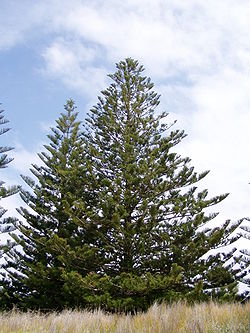
Ramification (botany)
Encyclopedia

In botany
Botany
Botany, plant science, or plant biology is a branch of biology that involves the scientific study of plant life. Traditionally, botany also included the study of fungi, algae and viruses...
, ramification is the divergence of the stem
Plant stem
A stem is one of two main structural axes of a vascular plant. The stem is normally divided into nodes and internodes, the nodes hold buds which grow into one or more leaves, inflorescence , conifer cones, roots, other stems etc. The internodes distance one node from another...
and limbs of a plant
Plant
Plants are living organisms belonging to the kingdom Plantae. Precise definitions of the kingdom vary, but as the term is used here, plants include familiar organisms such as trees, flowers, herbs, bushes, grasses, vines, ferns, mosses, and green algae. The group is also called green plants or...
into smaller ones, i.e. trunk
Trunk (botany)
In botany, trunk refers to the main wooden axis of a tree that supports the branches and is supported by and directly attached to the roots. The trunk is covered by the bark, which is an important diagnostic feature in tree identification, and which often differs markedly from the bottom of the...
into branch
Branch
A branch or tree branch is a woody structural member connected to but not part of the central trunk of a tree...
es, branches into increasingly smaller branches, etc. Gardeners stimulate the process of ramification through pruning
Pruning
Pruning is a horticultural practice involving the selective removal of parts of a plant, such as branches, buds, or roots. Reasons to prune plants include deadwood removal, shaping , improving or maintaining health, reducing risk from falling branches, preparing nursery specimens for...
, thereby making tree
Tree
A tree is a perennial woody plant. It is most often defined as a woody plant that has many secondary branches supported clear of the ground on a single main stem or trunk with clear apical dominance. A minimum height specification at maturity is cited by some authors, varying from 3 m to...
s, shrub
Shrub
A shrub or bush is distinguished from a tree by its multiple stems and shorter height, usually under 5–6 m tall. A large number of plants may become either shrubs or trees, depending on the growing conditions they experience...
s and other plants bushier and denser.
Short internodes (the section of stem between nodes, i.e. areas where leaves
Leaf
A leaf is an organ of a vascular plant, as defined in botanical terms, and in particular in plant morphology. Foliage is a mass noun that refers to leaves as a feature of plants....
are produced) help increase ramification in those plants that form branches at these nodes. Long internodes (which may be the result of over-watering, the over-use of fertilizer
Fertilizer
Fertilizer is any organic or inorganic material of natural or synthetic origin that is added to a soil to supply one or more plant nutrients essential to the growth of plants. A recent assessment found that about 40 to 60% of crop yields are attributable to commercial fertilizer use...
, or a seasonal "growth spurt") decrease a gardener's ability to induce ramification in a plant.
A high degree of ramification is essential for the creation of topiary
Topiary
Topiary is the horticultural practice of training live perennial plants, by clipping the foliage and twigs of trees, shrubs and subshrubs to develop and maintain clearly defined shapes, perhaps geometric or fanciful; and the term also refers to plants which have been shaped in this way. It can be...
as it enables the topiary artist to carve a bush or hedge into a shape with an even surface. Ramification is also essential to practitioners of the art of bonsai
Bonsai aesthetics
Bonsai aesthetics are the aesthetic goals and characteristics of the Japanese tradition in the art of growing a miniature tree in a container. Many Japanese cultural characteristics, particularly the influence of Zen Buddhism and the expression of wabi or sabi, inform the bonsai tradition in that...
as it helps recreate the form and habit of a full-size tree in a small tree grown in a container.
The pruning practices of coppicing
Coppicing
Coppicing is a traditional method of woodland management which takes advantage of the fact that many trees make new growth from the stump or roots if cut down. In a coppiced wood, young tree stems are repeatedly cut down to near ground level...
and pollarding
Pollarding
Pollarding is a pruning system in which the upper branches of a tree are removed, promoting a dense head of foliage and branches. It has been common in Great Britain and Europe since medieval times and is practiced today in urban areas worldwide, primarily to maintain trees at a predetermined...
induce ramification by removing most of a tree's mass above the root. Fruit tree pruning increases the yield of orchards by inducing ramification and thereby creating many vigorous, fruitful branches in the place of a few less-fruitful ones.

